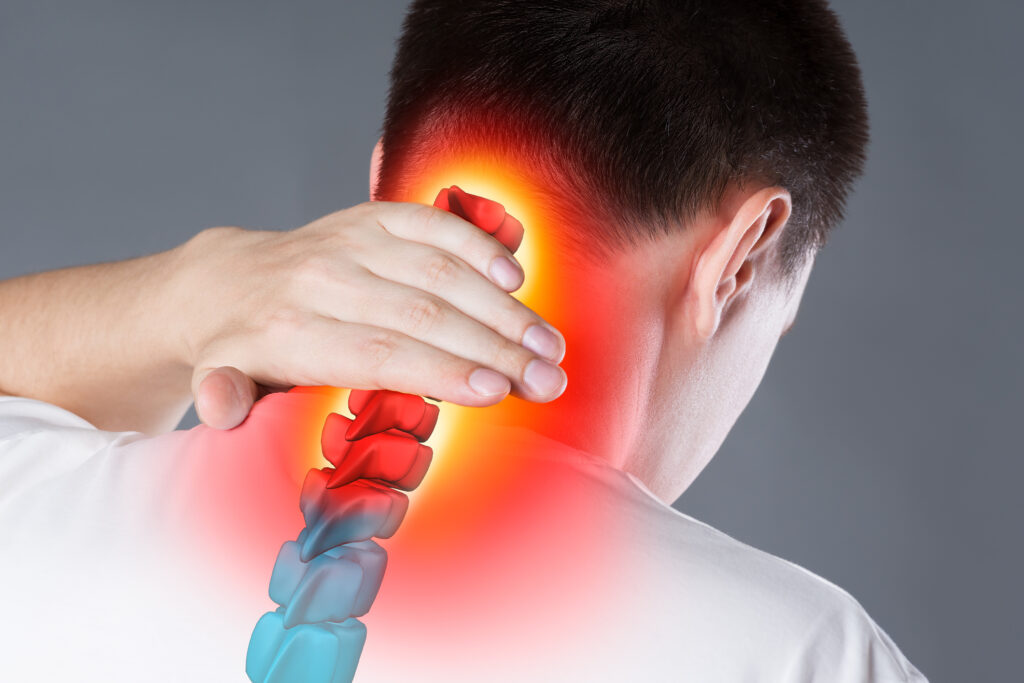Neck pain is a common complaint affecting people of all ages and lifestyles. Whether caused by poor posture, injury, or the natural aging process, neck pain can be debilitating, limiting mobility, and impacting day-to-day activities. Many people turn to chiropractors for relief because chiropractic care offers a drug-free, non-invasive solution to manage neck pain and improve overall spine health.
In this article, we will explore how chiropractic care can help alleviate neck pain and related conditions, including the different types of treatment chiropractors use. We will also highlight studies showing how chiropractic adjustments can significantly reduce neck pain and improve function.

Understanding Neck Pain
The neck, also known as the cervical spine, is composed of seven small vertebrae that support the full weight of your head. Because the neck is highly flexible, it is more vulnerable to injury and wear and tear compared to other parts of the spine. Neck pain can arise from various causes, including:
- Poor posture: Spending long hours hunched over a computer, smartphone, or other devices can lead to forward head posture, a leading cause of neck pain.
- Injury: Whiplash from car accidents, sports injuries, or falls can strain muscles and ligaments, causing acute or chronic neck pain.
- Degenerative conditions: Conditions like osteoarthritis and degenerative disc disease can lead to chronic neck pain by wearing down the joints, discs, and vertebrae.
- Muscle strain: Overuse, stress, or poor sleeping positions can result in tightness and pain in the neck muscles.
- Pinched nerves: Herniated discs or bone spurs in the cervical spine can compress nearby nerves, leading to neck pain, numbness, or tingling in the arms.
Types of Neck Pain
- Acute Neck Pain: This is sudden neck pain caused by injury, strain, or a specific event. Acute neck pain can last from a few days to a few weeks and often resolves with proper care.
- Chronic Neck Pain: Chronic neck pain persists for more than three months and may be due to ongoing issues such as poor posture, degenerative changes, or untreated injuries.
- Referred Neck Pain: Pain in other areas of the body, such as the shoulders or upper back, can radiate to the neck, often due to issues like poor posture, stress, or nerve compression.
Chiropractic care provides effective, holistic solutions for all types of neck pain, addressing both the symptoms and underlying causes.

How Chiropractic Care Helps with Neck Pain
Chiropractors specialize in treating musculoskeletal disorders, particularly those affecting the spine. Through manual adjustments, soft tissue therapies, and personalized rehabilitation exercises, chiropractors can address the root cause of neck pain, helping patients regain mobility and find long-term relief.
1. Chiropractic Adjustments
The core of chiropractic care for neck pain is spinal adjustments, also known as cervical manipulation. These adjustments involve applying precise, controlled force to specific areas of the cervical spine to improve alignment, relieve pressure on nerves, and restore proper movement.
When the vertebrae in the neck are misaligned, it can lead to nerve irritation, muscle tension, and restricted range of motion, all of which contribute to neck pain. Chiropractors use gentle adjustments to realign the vertebrae, improving spinal function and reducing pain.
Studies Supporting Spinal Adjustments for Neck Pain
A study published in The Spine Journal found that chiropractic spinal adjustments were effective in reducing neck pain in patients with acute and chronic neck pain. The study demonstrated that participants who received chiropractic care experienced significant improvements in pain levels, mobility, and overall quality of life compared to those who did not receive spinal manipulation.
Another study published in The Annals of Internal Medicine showed that patients with neck pain who received chiropractic adjustments had better outcomes in terms of pain relief and functional improvement compared to those who only used medications or exercise therapy.
2. Soft Tissue Therapy
In addition to spinal adjustments, chiropractors often use soft tissue therapies to relieve tension in the muscles surrounding the neck. Tight or strained muscles can exacerbate neck pain, especially in cases of poor posture or injury. Chiropractic care includes techniques like:
- Trigger point therapy: This involves applying pressure to specific points in the muscle to release tight areas and reduce muscle tension.
- Myofascial release: This is a hands-on technique that stretches and releases tension in the fascia, the connective tissue surrounding muscles.
- Massage therapy: Many chiropractors incorporate massage therapy to help relax muscles, improve blood flow, and promote healing in the affected area.
3. Decompression Therapy
For patients with neck pain caused by herniated discs or spinal stenosis (narrowing of the spinal canal), spinal decompression therapy can be highly effective. This technique gently stretches the spine, creating negative pressure within the disc to allow it to retract and relieve pressure on nearby nerves.
Decompression therapy can help reduce the pain associated with cervical disc herniation and improve neck mobility.
4. Postural Correction and Ergonomic Advice
Poor posture is a major contributor to chronic neck pain. Whether caused by slouching at a desk, poor sleep posture, or improper use of electronic devices, postural imbalances place excess strain on the neck and upper back muscles. Chiropractors assess your posture and offer corrective exercises to improve spinal alignment.
Ergonomic advice from chiropractors may include adjusting your workstation, changing your pillow, or modifying your daily habits to avoid neck strain. By addressing these issues, chiropractic care can help prevent future episodes of neck pain.
5. Rehabilitation Exercises and Stretching
To support the long-term relief of neck pain, chiropractors often recommend a personalized exercise program tailored to the patient’s condition. Strengthening the muscles that support the neck and improving flexibility can help reduce the likelihood of recurrent pain.
Chiropractors may prescribe specific neck stretches to improve flexibility in the cervical spine and exercises that strengthen the core and neck muscles. These exercises not only provide relief but also help prevent future injuries by improving overall spinal health.
6. Lifestyle and Nutritional Advice
In line with a holistic approach, chiropractors may offer nutritional and lifestyle advice to help manage inflammation and promote healing. For example, an anti-inflammatory diet rich in omega-3 fatty acids, antioxidants, and other nutrients may support the body’s natural ability to recover from injury and reduce chronic pain. Chiropractors may also discuss stress management techniques to prevent tension headaches and stress-related neck pain.

Related Conditions That Chiropractic Care Can Address
Chiropractic care is not only effective for general neck pain but also for specific related conditions, such as:
1. Cervical Disc Herniation
A herniated disc in the neck occurs when the soft center of a spinal disc bulges out, pressing on nearby nerves. This can lead to neck pain, numbness, tingling, or weakness in the arms. Chiropractors use spinal adjustments and decompression techniques to reduce nerve compression and promote healing.
2. Cervical Spondylosis (Spinal Arthritis)
As people age, the discs and joints in the cervical spine can degenerate, leading to a condition known as cervical spondylosis or spinal arthritis. This can cause neck pain, stiffness, and even nerve irritation. Chiropractic adjustments, soft tissue therapy, and lifestyle changes can help manage pain and improve mobility in patients with spinal arthritis.
3. Whiplash
Whiplash is a neck injury caused by sudden, forceful back-and-forth movement, typically from car accidents or sports injuries. It can lead to severe neck pain, stiffness, and headaches. Chiropractors specialize in treating whiplash by using spinal adjustments, soft tissue therapy, and rehabilitation exercises to restore function and alleviate pain.
A study published in the Journal of Orthopaedic & Sports Physical Therapy found that patients who received chiropractic care for whiplash injuries showed significant improvements in neck function and pain relief.
4. Cervicogenic Headaches
Cervicogenic headaches originate from issues in the cervical spine, often caused by poor posture, muscle tension, or spinal misalignment. Chiropractic adjustments help correct the misalignments that trigger these headaches, offering long-lasting relief.
A study published in The Journal of Manipulative and Physiological Therapeutics found that spinal manipulation provided effective relief for cervicogenic headaches, reducing both the frequency and intensity of headaches in patients.
5. Torticollis
Torticollis, also known as “wry neck,” is a condition in which the neck muscles contract involuntarily, causing the head to twist to one side. Chiropractic adjustments and soft tissue therapy can help relieve the muscle tension associated with torticollis, improving neck mobility.
Scientific Evidence Supporting Chiropractic Care for Neck Pain
Several studies support the effectiveness of chiropractic care in treating neck pain and related conditions:
- Chiropractic Adjustments for Acute and Chronic Neck Pain
- Study: Chiropractic Treatment for Acute and Chronic Neck Pain: A Randomized Clinical Trial
- Published In: The Spine Journal
- Summary: This study found that patients with both acute and chronic neck pain experienced significant pain reduction and functional improvement after receiving chiropractic spinal adjustments.
- Study: Chiropractic Treatment for Acute and Chronic Neck Pain: A Randomized Clinical Trial
- Spinal Manipulation for Cervicogenic Headaches
- Study: Effectiveness of Chiropractic Manipulation for Cervicogenic Headaches
- Published In: Journal of Manipulative and Physiological Therapeutics
- Summary: This study showed that chiropractic manipulation significantly reduced the frequency and intensity of cervicogenic headaches .
- Study: Effectiveness of Chiropractic Manipulation for Cervicogenic Headaches
- Chiropractic Care for Whiplash-Associated Disorders
- Study: The Role of Chiropractic Care in Treating Whiplash Injuries
- Published In: Journal of Orthopaedic & Sports Physical Therapy
- Summary: This study found that chiropractic adjustments and rehabilitation exercises improved function and reduced pain for patients with whiplash-associated disorders .
- Study: The Role of Chiropractic Care in Treating Whiplash Injuries

Conclusion
For those struggling with neck pain, chiropractic care offers a safe, effective, and holistic treatment option. Through spinal adjustments, soft tissue therapy, decompression, and personalized rehabilitation exercises, chiropractors can address the root causes of neck pain and provide lasting relief. Chiropractic care is also effective for treating related conditions such as cervicogenic headaches, cervical disc herniation, whiplash, and cervical spondylosis.
If you’re experiencing neck pain, consult a qualified chiropractor to develop a tailored treatment plan. By addressing both the symptoms and underlying causes, chiropractic care can help you achieve improved neck health, mobility, and quality of life.
References:
- Chiropractic Treatment for Acute and Chronic Neck Pain: A Randomized Clinical Trial
- Link to Study: The Spine Journal
- Link to Study: The Spine Journal
- Effectiveness of Chiropractic Manipulation for Cervicogenic Headaches
- Link to Study: Journal of Manipulative and Physiological Therapeutics
- Link to Study: Journal of Manipulative and Physiological Therapeutics
- The Role of Chiropractic Care in Treating Whiplash Injuries
- Link to Study: Journal of Orthopaedic & Sports Physical Therapy
